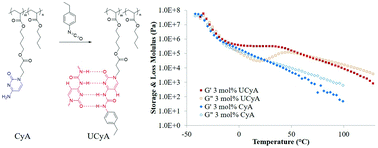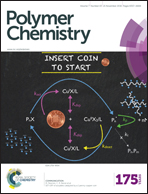Ureido cytosine and cytosine-containing acrylic copolymers†
Abstract
Regioselective Michael addition afforded a novel N1-substituted cytosine acrylate monomer for the synthesis of acrylic random copolymers with cytosine pendant groups. Quantitative post-functionalization converted cytosine to ureido-cytosine (UCy) with an increased self-association strength due to quadruple hydrogen bond formation. Thermogravimetric analysis (TGA) revealed a lower onset temperature of weight loss (∼200 °C) for UCy-containing copolymers, however, they proved to be more thermally stable at ≤130 °C than the cytosine-containing precursors during isothermal rheological experiments. The incorporation of UCy into random copolymers resulted in higher Tgs, enhanced mechanical performance, and better microphase-separation than the cytosine-containing precursors. Both dynamic mechanical analysis and rheological analysis revealed a plateau regime for each UCy-containing copolymer as well as a tan delta transition that corresponded to hydrogen bond dissociation. In contrast, the viscoelastic behavior of cytosine-containing random copolymers resembled entangled, non-associating polymers with increasing Tg as the cytosine content increased. A solution-cast UCy-containing copolymer film exhibited a more well-defined surface morphology with nano-fibrillar hard domains compared to the cytosine control. Variable temperature FTIR spectroscopy verified the presence of hydrogen bonding, and thermogravimetric sorption analysis (TGA-SA) compared the water uptake of UCy and cytosine-containing copolymers. UCy-containing random copolymers showed various advantages for applications as adhesives and thermoplastic elastomers compared to the cytosine copolymers, including superior cohesive strength, higher thermal stability, wider service temperature window, and lower moisture uptake. Free radical copolymerization of a quadruple hydrogen bond containing acrylic monomers provides a versatile avenue to supramolecular polymers with a tunable composition and improved scalability compared to earlier telechelic oligomers. This report describes the first synthesis of an acrylic monomer family and complementary evidence for tunable association in random copolymers.



 Please wait while we load your content...
Please wait while we load your content...